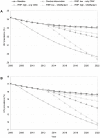The impact of pre-exposure prophylaxis (PrEP) on HIV epidemics in Africa and India: a simulation study
- PMID: 18461185
- PMCID: PMC2367053
- DOI: 10.1371/journal.pone.0002077
The impact of pre-exposure prophylaxis (PrEP) on HIV epidemics in Africa and India: a simulation study
Abstract
Background: Pre-exposure prophylaxis (PrEP) is a promising new HIV prevention method, especially for women. An urgent demand for implementation of PrEP is expected at the moment efficacy has been demonstrated in clinical trials. We explored the long-term impact of PrEP on HIV transmission in different HIV epidemics.
Methodology/principal findings: We used a mathematical model that distinguishes the general population, sex workers and their clients. PrEP scenarios varying in effectiveness, coverage and target group were modeled in the epidemiological settings of Botswana, Nyanza Province in Kenya, and Southern India. We also studied the effect of condom addition or condom substitution during PrEP use. Main outcome was number of HIV infections averted over ten years of PrEP use. PrEP strategies with high effectiveness and high coverage can have a substantial impact in African settings. In Southern India, by contrast, the number of averted HIV infections in different PrEP scenarios would be much lower. The impact of PrEP may be strongly diminished or even reversed by behavioral disinhibition, especially in scenarios with low coverage and low effectiveness. However, additional condom use during low coverage and low effective PrEP doubled the amount of averted HIV infections.
Conclusions/significance: The public health impact of PrEP can be substantial. However, this impact may be diminished, or even reversed, by changes in risk behavior. Implementation of PrEP strategies should therefore come on top of current condom campaigns, not as a substitution.
Conflict of interest statement
Figures


References
MeSH terms
LinkOut - more resources
Full Text Sources
Other Literature Sources
Medical
Miscellaneous

